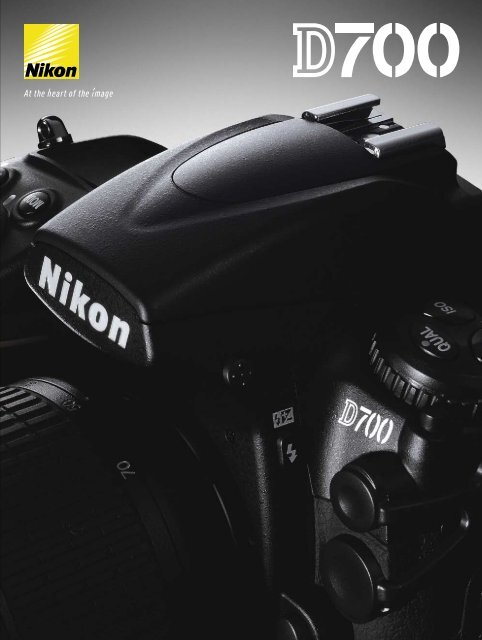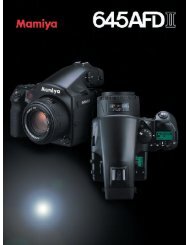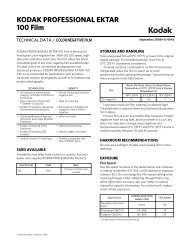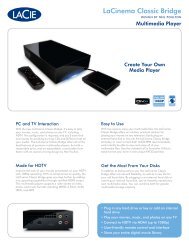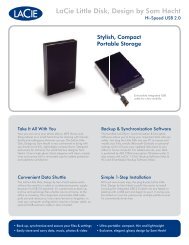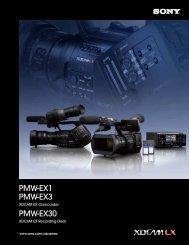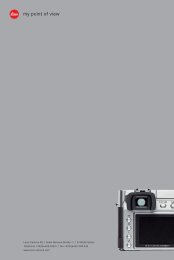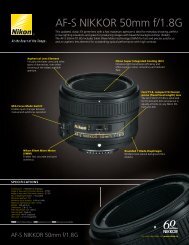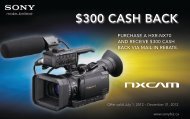Create successful ePaper yourself
Turn your PDF publications into a flip-book with our unique Google optimized e-Paper software.
Exceptional Performance. Agile Design.The first <strong>Nikon</strong> FX-format camera, the D3, represents aquantum leap in digital photography that forever changed theway professionals are able to work. Now, with the launch ofthe second <strong>Nikon</strong> FX-format camera — the <strong>Nikon</strong> <strong>D700</strong> — youcan achieve, in a smaller, lighter design, many of those sameextraordinary imaging feats that made the <strong>Nikon</strong> D3 an immediatelegend. Like the D3, the <strong>D700</strong> transcends the expectations ofthe world's leading photographers, in an agile body developedfrom the award-winning DX-format D300. In soft, subtle lighting,it captures seductively smooth tones with astonishingly rendereddetail — easily. In low-lit situations, it delivers virtually noisefreeimages for impeccable results at up to ISO 6400 — easily.And if you’re faced with constantly changing lighting conditions,the <strong>D700</strong> handles these complex exposure changes with ISOsensitivity auto control — easily. When your day is long anddemanding and you need to travel light, you’ll appreciate thiscamera’s portability, responsiveness and finely balanced handling.And when you need more speed to capture a crucial moment,the <strong>D700</strong> delivers with the option of a multi-power battery packthat gives you up to 8 frames per second*, continuous shooting.Whether your subject’s fast, slow or still, you’ll capture it withtack-sharp precision using <strong>Nikon</strong>’s exclusive 51-point AF system— easily. Every aspect of the <strong>D700</strong> has been carefully engineered,to provide you with the freedom to work efficiently and with theutmost sensitivity, as a natural extension of your personal vision.The <strong>D700</strong> achieves a remarkable distillation of the finest imagingperformance digital photography can offer.*With EN-EL4/4a and AA-size batteries2
Move beyond difficult lighting conditions
• Lens: AF-S NIKKOR 24-70mm f/2.8G ED • Exposure: [A] mode, 1/13 second, f/8 • White balance: Auto • Sensitivity: ISO 3200 • Picture Control: Standard©Cherie Steinberg Cote
<strong>Nikon</strong> FX format and renowned NIKKOR lenses:• Lens: AF-S NIKKOR 14-24mm f/2.8G ED • Exposure: [A] mode, 1/800 second, f/11 • White balance: Auto • Sensitivity: ISO 400 • Picture Control: Standard©Cherie Steinberg CoteYour foundation for exceptional images: The12.1-megapixel <strong>Nikon</strong> FX-format CMOS sensorIncorporating the same <strong>Nikon</strong>-original FX-format CMOSimaging sensor developed for the groundbreaking D3, thenew <strong>Nikon</strong> <strong>D700</strong> delivers immaculately clean images. Indeed,the combination of the overall precision and light-handlingefficiency of this sensor with the legendary performance ofNIKKOR interchangeable lenses is integral to the outstandingpicture quality shared by these two extraordinary cameras.<strong>Nikon</strong> engineers understand the importance of transforminglight into electrical signals as early in the process as possible,so they conducted a vast number of trials to construct asophisticated imaging sensor design featuring nanometricprecision and absolute minimum loss. This is one of the keyreasons that images produced by the <strong>D700</strong> don't simply rivalthe resolution and tonal nuances of film — it's a standardthat the <strong>D700</strong> clearly exceeds. The large <strong>Nikon</strong> FX formatand 12.1-megapixel resolution are major factors supportingthis incomparable image quality. Each pixel hasample space to preserve details —even in shadows and highlights — thatlesser cameras find impossible. Withthis level of quality, you can expectimage integrity that goes farbeyond the numbers .6
Made for each otherThe NIKKOR lens advantageThe praise heaped upon NIKKOR interchangeable lenses hasbeen earned legitimately. So prepare yourself for images thatexhibit extraordinary sharpness, colour, saturation and contrast— from a comprehensive selection of outstanding zoom,super wideangle, wideangle, normal, telephoto and supertelephoto NIKKOR lenses. The <strong>Nikon</strong> FX format enablesphotographers to once again take advantage of the familiarperspective characteristics of 35mm m photography. And<strong>Nikon</strong> has painstakingly adapted the c characteristicsof a wide range of NIKKORs, both old and new, to the <strong>D700</strong>’s<strong>Nikon</strong> FX-format sensor for superb results.The <strong>D700</strong> enables you to use a broad spectrum of NIKKORlenses while retaining the lens’ native angle of view. In cropmode, you can broaden the <strong>D700</strong>’s versatility through theuse of DX NIKKORs. And up to nine manual focus NIKKORscan be registered to provide even more <strong>D700</strong> systemcompatibility.Lateral chromaticaberration reduction©Cherie Steinberg CoteWithLateral chromatic aberration reduction Colour fringes, also known as chromatic aberration, aregenerated because varying wavelengths of light result insl t o overcome this unwantedrporates <strong>Nikon</strong>’s exclusive lateralchromatic aberration reduction function. Unlike conventionalcorrection methods that merely eliminate the colours ofchromatic aberration, <strong>Nikon</strong>’s method compensates for theences in the resolving index for each colour, making itparticr reducing the image distortion atthe edges of a frame in addition to improving image qualitythroughout the entire frame. Moreover, because aberrationis corrected regardless of lens type, this feature deliverssharper images whichever NIKKOR you use.Integrated Dust Reduction SystemWithout<strong>Nikon</strong> meticulously developed this system, analyzing thecharacteristics of a myriad of image-degrading particulates soas to fully evaluate performance and reliability in a wide rangeof temperatures and humidity levels. One key componentof the system is the Image Sensor Cleaning function, whichemploys piezoelectric elements to generate vibrations at fourspec c frequencies to optimize dust removal. Image SensorCleaning can be set for automatic activation when the cameray time the photographer feels it'snecessary.Piezoelectric element<strong>D700</strong> Image Sensor Cleaning function• Lens: AF-S NIKKOR 14-24mm f/2.8G ED • Exposure: [M] mode, 1/4 second,f/11 • White balance: Auto • Sensitivity: ISO 200 • Picture Control: Standard©Jim Reed7
Low noise high ISO delivers faster shutter speeds,Rich tonal gradation, wide dynamic range: 14-bit A/D conversion followed by 16-bit image processingAnother key to the <strong>D700</strong>’s outstanding imagequality is <strong>Nikon</strong>’s powerful, state-of-the-artEXPEED image-processing, a technology itshares with the D3. Rich data captured withthe <strong>Nikon</strong> FX-format 12.1-megapixel CMOS sensor maintainsan extremely high signal-to-noise ratio throughout 14-bitA/D conversion and the numerous stages of 16-bit imageprocessing. This ensures smooth tonal gradations, the estshadow details and continuous transition even in highlights— delivering unparalleled results in an astounding variety oflighting situations, be they well-lit, backlit or poorly lit.Colours remain well-saturated and accurate even intransition, contributing to image depth that is simplynot possible with lesser cameras. This technologyapplies not only to <strong>Nikon</strong>’s NEF, but also toJPEG s, which often require no post-processing andare ready for immediate printing. <strong>Nikon</strong>'s exclusive EXPEEDtechnologies process rich data at phenomenal speeds. Andunlike many digital cameras, everything is handled by a singleengine, conserving t battery power. This, combinedwithr memory, gives you greater breadth incrucial situations, including extended shoots of fast-movingsubjects, such as sports or wildlife.14-bit A/D conversion and 16-bit image-processing pipelinem ISO 200 through 6400The <strong>D700</strong>’s high signal-to-noise ratio contributes toimpeccably clean imagee broadest span ofISO settings. The <strong>D700</strong>’s standard range extends from ISO200 to ISO 6400, and whichever setting you select, the <strong>D700</strong>delivers outstanding image quality. Now, you can choose highISO settings without hesitation and be assured of imagesthat exhibit remarkably low noise. And when conditionsdemand it, you can also go lower to ISO 100 and higher toISO 12800 or even ISO 25600.Finalprocessing<strong>D700</strong>'s high image quality throughout wide ISO settings12-channel parallelreadout14-bit A/Dconversion16-bit image processingan incredibly high signal-to-noise ratio.ISO 200 ISO 400 ISO 800 ISO 1600 ISO 3200 ISO 6400©Cherie Steinberg Cote8
smaller apertures for sharper, cleaner images• Exposure: [A] mode, 1/80 second, f/2.8 • White balance: Auto• Sensitivity: ISO 3200 • Picture Control: Standard©Douglas Menuez• Exposure: [A] mode, 1/30 second, f/2.8 • White balance: Auto• Sensitivity: ISO 6400 • Picture Control: Standard ©Douglas MenuezComprehensive strategy to reduce noiseThe <strong>D700</strong> is designed to reduce noise even before the menuactivatedHigh ISO NR settings are applied. And at higherISO settings of 2000 and over, with the High ISO NR turnedon, it’s activated automatically but in a manner designed togive you rich, satisfying, natural saturation a world beyondthe synthetic appearance of conventional image processingsystems.Superior results instantly, even in difficult lightingconditionsAccess to high ISO settings that deliver superior imagefiles gives you so many more exposure options for shootingexceptional pictures in situations that were formerly beyondyour grasp. Poorly lit scenes that used to take time forlighting setup can now be captured immediately. Whenshooting in more subtle conditions, such as on an overcastday, you won’t have to sacrifice aperture settings for thesake of shutter speed. Simply boost the ISO and use a fastershutter speed to achieve superior results. At locations wheretripods and monopods are prohibited or are inconvenient touse, you can still obtain superb handheld results. And withNIKKOR VR (Vibration Reduction) lenses, the shot you wantis a given. Scenes that you long considered difficult or evenimpossible are yours for the taking, and capturing them hasnever been easier.• Exposure: [A] mode, 1/400 second, f/2.8 • White balance: Auto • Sensitivity: ISO3200 • Picture Control: Standard ©Cherie Steinberg CoteAuto ISO settingFor shooting opportunities where you need to deal withconstantly changing light, ISO sensitivity auto control canbe a major advantage, eliminating the need to sacrificeeither aperture or shutter speed. Taking pictures with ISOsensitivity auto control enables you to limit how high youwant the camera to allow the ISO to rise while selectingyour preference for slowest permitted shutter speed. Nowyou can go with your instincts in Programmed- or Aperturepriorityauto, or simply lock the aperture and shutter speedcombination you want in manual mode and let the <strong>D700</strong>judge the lighting situation for you, determining the optimumISO for constant exposure results.Active D-LightingAutomatically regulating the dynamic range when the contrastis too great lets you preserve highlights, such as those in thesky or a clear halo around the sun, and shadow details. The<strong>D700</strong> employs <strong>Nikon</strong>’s new Active D-Lighting, which worksautomatically when needed, so you can leave it on, knowing itwill activate only when conditions indicate a need.9
Freeze the action, perfect your composition• Lens: AF-S NIKKOR 400mm f/2.8G ED VR • Exposure: [A] mode, 1/1,250 second, f/5 • White balance: Auto • Sensitivity: ISO 320 • Picture Control: Vivid• Dynamic-area AF mode 51-point 3D-Tracking©Douglas Menuez51-point AF systemThe strategically positioned 51 AF points of the <strong>D700</strong>'s Multi-CAM 3500FX AF sensor module are identical with thoseof the D3, and keep your subject in focus, even with quickand/or erratic subject movement, across a wide extent of theframe. The result is tack-sharp images and the opportunityto explore a greater variety of compositions. The highlyresponsive AF sensor detects your subject in EV as low as-1. The 15 points of the three center rows employ cross-typesensors for extra-powerful detection with any NIKKOR lensof f/5.6 or faster, far exceeding the limitations imposed bysimilar competing systems, contributing further to the <strong>Nikon</strong>system’s broad range of superior performance and versatility.After all, accurate autofocus while tracking a crucial subjectisn’t a luxury — it’s a necessity.Wide area coverage with51 AF points15 cross-type sensors performwith any AF NIKKOR f/5.6 orfaster lensThe MB-D10 is easily attached and detached, and workswith EN-EL4/4a*, EN-EL3e, and AA-sizebatteries.*Battery holder BL-3 is required.
Versatile AF area modesThe <strong>D700</strong>’s three AF area modes — Single-point AF, Dynamic-areaAF, and Auto-area AF — prepare you for any shooting situation.With good light control and a static subject, Single-point AFensures that the most important element in your composition,such as the eyes in a character portrait, will be sharply focused.With Dynamic-area AF, you can select from several focusingoptions, utilizing 9, 21 or all 51 points. Just select a single AF pointas your priority, and the areas surrounding it serve as backup — asignificant advantage when shooting moving subjects. Select thenine-point option when you want to focus on erratically movingsubjects with greater accuracy. When dealing with insufficientcontrast for fast focus detection, choosing 21 or 51 points makesdetection easier. The 51-point option allows for 3D-Trackingwhich uses colour information from the 1,005-pixel RGB sensorto automatically follow moving subjects across the AF points. Yetunlike other Dynamic-area AF systems, you don’t have to manuallyreposition the AF point to continue tracking the subject, whichmeans you can concentrate more on composition. Auto-area AFalso uses colour information and special face recognition algorithmsto automatically focus on an individual’s face, extremely helpful forsituations when there’s simply no time to select a focus point orwhen using Live View in Hand-held mode at high or low angles.Single-point AF modeDynamic-area AF mode using 9 points©Douglas Menuez©Douglas MenuezSpeed, response, and power at up to 8 frames persecondWith a startup time of 0.12 seconds and shutter release timelag as short as 40 milliseconds (CIPA standard), the compact,lightweight <strong>D700</strong> combines speed, response and power to rivalthe professional <strong>Nikon</strong> D3. If it's agility you require, use the <strong>D700</strong>in its lightest configuration for a remarkable 5 frames per second.For even greater speed, attach the Multi-Power Battery PackMB-D10 to boost shooting to a rapid-fire 8 frames per second*— ideal for sports or other action photography. With the <strong>D700</strong>as is, you can shoot as many as 1,000 frames, while addingthe MB-D10 enables you to go for a massive 2,900. The Multi-Power Battery Pack's contours seamlessly meld with the <strong>D700</strong>,providing a comfortable grip for vertical composition shootingand a reassuring stability when attached to a tripod or a long,heavy lens. The <strong>D700</strong> also supports next-generation UDMAtechnology, giving you an extra boost of recording speed, andenabling you to shoot more consecutive shots — for never-to-berepeatedshooting opportunities.*With EN-EL4/4a and AA-size batteriesDynamic-area AF mode using 21 pointsAuto-area AF©Douglas Menuez©Douglas MenuezWith the Multi-Power Battery Pack MB-D10 attached, the <strong>D700</strong> fires at up to an impressive 8 frames per second.©Douglas Menuez
Scene Recognition System: A new level of auto• Lens: AF-S VR Zoom-Nikkor 70-200mm f/2.8G IF- ED• Exposure: [A] mode, 1/160 second, f/2.8 • White balance: Auto • Sensitivity: ISO 3200 • Picture Control: Standard©Douglas MenuezScene Recognition System<strong>Nikon</strong>’s revolutionary Scene RecognitionSystem red nes the scope, accuracy andperformance of Digital SLR automatic control.One way it does this is by expanding thepotential of the renowned 1,005-pixel RGB sensor far beyond3D Coloush control, applyinginformation from it to autofocus and auto white balanceprocesses as well, thereby introducing a whole new levelof accuracy and performance. The key to this revolutionarytechnology is a unique optical device that enables moreprecise colour information readouts for an unprecedentedlevel of detailed scene information and analysis. This enablesthe <strong>D700</strong> to know and understand additional and essentialelements within the scene you're about to shoot. Each sceneis analyzed milliseconds prior to shutter release, furtheroptimizing autofocus, auto exposure, i-TTL control and whitebalance — before the image is captured. Think of the SceneRecognition Systemistant,working tirelessly alongside you.Precise colour information for outstanding AFaccuracyThe <strong>D700</strong>’s precise colour information readouts deliverauto focusthat no other camera maker can imitate. Use any of theDynamic-area AF modes — 9, 21, or 51 points — and thecolour information of your main subject guides the <strong>D700</strong>’s AFsystem to continue tracking your subject, whether it movestoward the camera, away from the camera, or from side toside. Colour information is integral to 3D-Tracking, which usescolour to constantly follow the subject, switching focus pointsas needed to allow you to concentrate on ideal compositionwithout worrying about keepingthe subject in focus. In AutoareaAF mode, the <strong>D700</strong>automatically recognizes peopleand skin tones, quickly focusingon the most important element— the human face.12
control accuracyHighly sophisticated auto and ash exposure results<strong>Nikon</strong>'s 3D Colour Matrix Metering II has long been praisedby discerning professionals for its superior and consistentaccuracy. Indeed, it delivers exposure results faithful to whatthe photographer actually sees in various lighting situations,such as front, side and back lighting. The system analyzesa host of scene conditions — such as brightness, contrast,selected AF area, colour, subject-to-camera distance and eventhey of a scene — then compares theseelements with an in-camera database containing informationfrom over 30,000 actual shooting situations for incredibleexposure precision. <strong>Nikon</strong>’s unique Scene RecognitionSystem’s highlight analysis combined with the <strong>D700</strong>’s imageprocessing gives you images that accurately retain their tonesas well asin highlights and shadows.• Lens: AF-S NIKKOR 24-70mm f/2.8G ED • Exposure: [A] mode, 1/60 second, f/8 • Whitebalance: Auto • Sensitivity: ISO 200 • Picture Control: Standard©Cherie Steinberg CoteAccurate Auto White Balance, even with a mix oflight sourcesAuto White Balance works together with <strong>Nikon</strong>'s SceneRecognition System to give you so much more. Millisecondsbefore shutter release, the <strong>D700</strong>’s 1,005-pixel RGBinformation assists the camera in calculating the in-depthcharacteristics of the scene, cross-referencing it with 5,000actual picture data examples among the over 20,000 imagesstored in the <strong>D700</strong>’s AWB database. This lets you shoot witheven in tricky conditions such as mercury vaporlighting, orange sodium lighting, and mixed light sources thatwould easily confuse lesser cameras. With the <strong>D700</strong>, whitestays white, yellow appear s as yellow, just the way you seeit. The results are astonishing, and immensely satisfying.Active D-Lighting On• Lens: AF-S NIKKOR 24-70mm f/2.8G ED • Exposure: [A] mode, 1/400 second, f/2.8• White balance: Colour Temperature (5000K) • Sensitivity: ISO 250• Picture Control: Standard©Douglas Menuez• Lens: AF-S NIKKOR 24-70mm f/2.8G ED • Exposure: [M] mode, 1/30 second, f/2.8• White balance: Auto • Sensitivity: ISO 3200 • Picture Control: Standard©Douglas Menuez13
Colour and depth you've only dreamed about
• Lens: AF-S VR Zoom-Nikkor 24-120mm f/3.5~5.6G IF-ED • Exposure: [A] mode, 1/200 second, f/4.2 • White balance: Color Temperature (5000K) • Sensitivity: ISO 640 • Picture Control: Standard©Douglas Menuez
Engineered so nothing gets in your way40-millisecond shutter responseThe <strong>D700</strong> works as fast as you do, enablingyou to capture the precise moments youwant. That’s why the shutter release timelag was cut to an industry-leading 40milliseconds (CIPA standard). Just composeand the camera will capture your subject’severy move — critical when shooting fastmovingsubjects.Comprehensively sealed against dust and moistureThe <strong>D700</strong> goes the extra mile to protect against invasive moisture, dust, and evenelectromagnetic interference. A meticulous, systematic series of O-rings and other specializedseals, combined with additional <strong>Nikon</strong> protective engineering, keeps you shooting when lessercameras fail.Durable, high-precision shutter unitTested on fully assembled cameras, the<strong>D700</strong>’s shutter unit has been proven through150,000 cycles under the most demandingconditions. <strong>Nikon</strong>’s exclusive self-diagnosticshutter constantly monitors shutter operation,confirming that it is operating at preciselythe designated shutter speed. Deviations arecorrected automatically, maintaining shutterspeed accuracy for more precise exposures.Precision-cast magnesium alloybodyThe <strong>D700</strong> features rugged, durable andlightweight magnesium alloy for the body,exterior cover, chassis, and mirror box, to protectthe advanced technologies within and ensureits ability to perform in the most demandingshooting conditions. <strong>Nikon</strong> also conducts severeanti-shock tests to assure robust reliability ofperformance. Magnesium alloy is also utilized inthe Multi-Power Battery Pack MB-D10.0.12-second start-up timeAs with all other <strong>Nikon</strong> digital SLR cameras,the <strong>D700</strong>’s power switch is convenientlylocated in front of the shutter release buttonfor natural, fluid operation. Start-up time hasbeen minimized to 0.12 second to ensureyou’re ready for every shooting opportunity.Mirror balancer for longerviewing timeWhen the shutter is released, the mirror cyclesup and down at a very high speed. <strong>Nikon</strong>'sunique precision mirror balancer instantlycancels mirror bounce by absorbing shock.As a result, the viewfinder blackout time andmirror movement noise are minimized.16
Function button enables instantshooting in NEFThe <strong>D700</strong> features a function button youcan designate for shooting in NEF. Whenshooting in JPEG and you decide to alsotake the next shot in NEF, pressing thebutton readies you instantly, without havingto access a menu.Easy-to-view camera setting displayAll of your settings are easily confirmed inthe large, high-definition LCD with clear,easy-to-read fonts. You can choose to displayinformation with black lettering against awhite background or vice versa. It’s alsopossible to set the camera to differentdisplays that match diverse ambient lightingconditions, and so achieve the ideal view forany situation.Info buttonPushing the info button twice takes youdirectly to useful features such as PictureControl, Active D-Lighting and NoiseReduction.Large, bright viewfinderPut your eye to the <strong>D700</strong>’s large circular eyepiece and rediscover why acamera’s viewfinder experience cannot be taken for granted. One lookthrough a <strong>D700</strong> confirms that superior viewfinder design is at the heartof single-lens reflex camera handling. The <strong>Nikon</strong> FX format and largepentagonal prism deliver a large, bright viewfinder image, making accurateDX-format cropcomposition easier for any shooting conditions. What’s more, the <strong>D700</strong>’sexpertly designed viewfinder enables skilled photographers to confirm focus visually, in either autoor manual focus mode.3-inch, 920,000-dot LCDThe large, high-resolution colour LCD monitordelivers bright, crisp image playback, withenlargements up to 27x (large-size images inFX format), for immediate and precise imageconfirmation. Each <strong>D700</strong> LCD is individuallyfine-tuned to deliver consistent, outstandingdisplay performance.Long-life batteryUsing the EN-EL3e, the same battery used inthe D300, the <strong>D700</strong> lets you shoot up to 1,000frames per charge (CIPA standard) thanks tointelligent power management. And by addingthe EN-EL4a in the optional Multi-PowerBattery Pack MB-D10, you can shoot up to2,900 frames. All power options enable you tomonitor the level of battery power and shotsremaining on a charge.Multi-Power Battery Pack MB-D10 (option)The optional Multi-Power Battery Pack MB-D10, which uses one RechargeableLi-ion Battery EN-EL4a/4/3e or eight AA-sizebatteries, is equipped with a shutter-releasebutton, AF-ON button, multi selector, andmain- and sub-command dials.Inspired layout, intelligentlyapplied ergonomicsThe <strong>D700</strong> gives you easy access, via buttons,to functions often required while shooting,eliminating the need for time-consumingmenu searches. The size and layout of allbuttons and dials have been optimized toreduce the chance of error. They’re alsoconsistent with <strong>Nikon</strong>’s other professionalD-SLRs to make the use of multiple cameraplatforms substantially easier.17
Live View further expands shooting opportunities• Lens: PC-E NIKKOR 24mm f/3.5D ED • Exposure: [M] mode, 1/8,000 second, f/8 • White balance: Auto • Sensitivity: ISO 800 • Picture Control: Standard©Cherie Steinberg CoteLive View with high-resolution, 920,000-dot LCD18The <strong>D700</strong>’s Live View function further expands versatilityin a variety of shooting situations. In studio photography,for example, the <strong>D700</strong>’s LCD shows bright, crisp, beautifulimages through a 3-inch, 920,000-dot screen in real time.Because it’s so large and clear, you’re always aware ofwhat's happening in your composition. The 170-degree wideviewing angle allows you to see what’s going on in front ofthe camera from extremely high or low angles. The <strong>D700</strong>offers two modes — Tripod and Hand-held.Sharp contrast AF in tripod modeTripod Mode is ideal for conditions that demand a precisefocus and involve detailed composition, such as studio stilllife, architecture and landscape photography. In this mode,the high-precision, contrast-detect AF system, using theFX-format CMOS sensor, offers exceptionally accuratefocusing from any point in the entire frame — much widerthan the 51-AF point area. You can easily rearrange still lifesubjects while simultaneously confirming your composition,or confirm your focus by enlarging the focus point imageSame setting as topphoto but withoutlens shiftingup to 13 times — an indispensable feature for macrophotography where subtle changes in the subject’s positiongreatly influence the depth of field. You can also control focusand shutter release from apersonal computer via CameraControl Pro 2. When usedin combination with <strong>Nikon</strong>’slatest PC-E NIKKOR lenses,which incorporate tilt and shiftfunctions, the Live View TripodMode further empowers you topursue your creative instincts.Live View offers two modes —Tripod Mode and Hand-heldMode — accessible through theLCD monitor.
— Comprehensive PC-E and Micro lensversatilityElectronic Virtual HorizonThe innovative Virtual Horizonprovides instant, accurateconfirmation of the <strong>D700</strong>’s positionrelative to horizontal level. Whenusing Live View, you can chooseto display the virtual horizon on theLCD, a feature ideal for landscapeand architecture photography. You canalso level the <strong>D700</strong> while looking throughthe viewfinder using the convenientanalog scale.Hand-held mode for low- and high-anglecompositionsJoining the <strong>D700</strong> are four NIKKOR lenses that give photographersexciting opportunities to develop in new and specialized directions.All of these lenses incorporate a number of exclusive NIKKOR lenstechnologies, such as Nano Crystal Coat, for achieving stunningimages, setting a new standard for effective control of ghost andflare. The three PC-E lenses offer shift and tilt functions as wellas the revolving mechanism, and their anti-dust and anti-moistureconstruction makes them a joy to work with even in severeconditions. The micro NIKKOR employs an internal focusing systemfor even faster autofocus and better balanced handling.PC-E NIKKOR 24mm f/3.5D EDFeatures Nano Crystal Coat, three EDglass elements, three aspherical lenselements and a closest shooting distanceof 0.21m.In situations where you’re unable to look through theviewfinder, Hand-held Mode can be a tremendousassistance. First, select your focus point from the 51 pointsavailable, or use Auto-area AF, then use the wide, 170-degreeviewing angle for composing — remarkably easy, even whenholding your <strong>D700</strong> overhead or close to the ground.PC-E Micro NIKKOR 45mmf/2.8D EDFeatures Nano Crystal Coat, an EDglass element, and a closest shootingdistance of 0.25m.Quick access to Live ViewA simple custom setting allows you to designate the functionbutton for quick access to Live View. One push of the buttonand you’re ready for Live View shooting.PC-E Micro NIKKOR 85mmf/2.8DFeatures Nano Crystal Coat and aclosest shooting distance of 0.39m.AF-S Micro NIKKOR 60mmf/2.8G EDFeatures Nano Crystal Coat, an EDglass element, three aspherical lenselements for the first time in a microlens, a fast-and-quiet silent wavemotor, a closest shooting distance of0.185m, and a reproduction ratio ofup to 1:1©Cherie Steinberg Cote• Lens: AF-S Micro NIKKOR 60mm f/2.8G ED • Exposure: [M] mode, 1/200 second, f/6.3• White balance: Auto • Sensitivity: ISO 200 • Picture Control: StandardWT-4/4A Wireless TransmitterFor photographers working in large, crowded venues, the WT-4/4AWireless Transmitter offers huge advantages. Supporting both theIEEE 802.11a and IEEE 802.11b/g, it gives you the range to movefreely. And to streamline image transfer, you can sendjust thumbnail images first; then, the complete dataof only the editor's selections need be transmitted— a real timesaver. Up to five photographers at atime can use the system, which means that a singleunit is able to handle most events. The WT-4/4A isalso compatible with a variety of system formats andsecurity protocols.19
Capture images with your own customized look and feelInnovative, versatile Picture ControlDefine tones and colours easilyThe <strong>D700</strong> provides rich tones and colours in the defaultsetting, but also gives you the freedom to custom tailorimage characteristics to your own specific tastes or clientrequirements. Picture Control is an intuitive, easy-to-usesystem for defining the image tone. In certain respects, itis reminiscent of the way in which film photographers onceselected certain types of film stock for specific shootingsituations. Tones defined by the Picture Control System willremain consistent with future <strong>Nikon</strong> digital SLR cameras thatare compatible with Picture Control System. You'll also haveaccess to optional Picture Controls to be introduced in thefuture via the <strong>Nikon</strong> Website.Standard©Cherie Steinberg CoteFour types of Picture ControlsSelect [Standard] for bright, balanced images suitable forany application. [Neutral] is designed to reproduce accuratecolour and gradation, making it your choice when you plan tomake post-production image enhancements. [Vivid] deliversdistinct, colourful, fresh-looking images with just the rightemphasis on your subject’s contrast and contours, making itideal for emphasizing primary colours, while [Monochrome]provides classic styles like black-and-white and sepia. Youcan even edit or change the Picture Controls using <strong>Nikon</strong>'sViewNX browsing software, or with the optional Capture NX2 with U Point technology — something no other cameramanufacturer offers.Neutral©Cherie Steinberg CoteDirect, intuitive image control[Standard], [Neutral], and [Vivid] enable you to adjustparameters such as sharpening, contrast, brightness,saturation and hue. With [Monochrome], you can fine-tunesharpening, contrast, brightness, filter effects and toning.Changes can be saved as Custom Picture Controls underyour chosen name for future use with particular shootingscenarios.Vivid©Douglas MenuezQuick adjust: Enjoy instant access to five parameters — sharpening,contrast, brightness, saturation and hue in [Standard] and [Vivid]Picture Controls. It’s all as easy as moving the sliders.20Monochrome©Douglas Menuez
Simple to use yet sophisticated: <strong>Nikon</strong>'s Creative Lighting SystemBuilt-in flash with 24mm lenscoverage and i-TTL flash controlThe <strong>D700</strong> is fullycompatible with <strong>Nikon</strong>'sunmatched CreativeLighting System, whichincludes i-TTL flashcontrol and Advanced Wireless Lighting.The camera’s Scene Recognition System'shighlight analysis further refines the world'smost sophisticated digital SLR lightingsystem. Utilizing the 1,005-pixel RGB sensorfor a more refined flash metering evaluation,this system reduces overexposure toa degree never before achieved, evenwith small subjects, which can easily beoverexposed. Metering accuracy for scenescontaining highly reflective objects has alsobeen substantially advanced. The built-inflash has 24mm lens coverage, and worksas a wireless commander for up totwo groups of remote Speedlightsin Advanced Wireless Lighting.• Lens: AF-S NIKKOR 24-70mm f/2.8G ED • Exposure: [M] mode, 1/80 second, f/11 • White balance: Auto • Sensitivity: ISO 200• Picture Control: StandardSpeedlight SB-900• Fully compatible with <strong>Nikon</strong>'s Creative Lighting System• Guide number: 34 (ISO100, m), 48 (ISO200, m) at35mm in normal lighting• Wide auto zoom coverage of 17-200mm• Automatic detection of imaging sensor format forsuperior light distribution• High-speed recyclingSB-800SB-600©Douglas MenuezSB-400Seamless workflow in new directionsCapture NX 2 (option)<strong>Nikon</strong>’s proprietary image processing softwarelets you get the most out of your NEF, JPEG orTIFF images. Capture NX 2 and its innovative U Pointtechnology empower you to:• Alter and enhance colour and details quickly andthoroughly• Create and customize your own colour schemes usingPicture Control, then save the results for later use orexport to D-SLRs that support Picture Control• Take advantage of important functions such as batchprocessing, edit list, vignette control, colour aberrationcontrol and distortion controlCamera Control Pro 2 (option)Remote shooting has never been moreproductive. Camera Control Pro 2 provides:• Full control of Live View, Picture Control, White Balanceand the 51-point AF system• Remote control and image transfer via wireless LANwhen using the WT-4/4A Wireless Transmitter• Deletion of unwanted images before data transfer• Image display using ViewNXImage Authentication Software (option)Protect your data's integrity with <strong>Nikon</strong>'s ImageAuthentication Software:• Indicates whether an image has been altered• Recognizes any change in XMP and IPTC informationViewNXProfessional NEF shooters have a powerful allyin <strong>Nikon</strong>'s ViewNX software. ViewNX treatsWith the ViewNX advantage, you can:• Switch from JPEG to RAW details in one click• Edit XMP and IPTC information• View thumbnails and previews quickly• Easily switch between <strong>Nikon</strong> Transfer and Capture NX 2• Customize images via ViewNX's Picture Control utility• Easily print, create slideshows and send images viaemail<strong>Nikon</strong> TransferTransfer enables you to:• Transfer images from <strong>Nikon</strong> D-SLR or memory cards• Add labels, ratings and IPTC at transfer time for• Continue selecting images while transfer is in progress21
Nomenclature< ;:/.-,+onmlkjih1234567~)(&%$#"!9=>?@[\]^gfedcba*8_ { | }123456789Exposure mode/Format buttonExposure compensation/Two-buttonreset buttonShutter-release buttonPower switchSub-command dialDepth-of-field preview buttonFunction buttonMirrorFocus-mode selector10 Lens release button11 Lens mountingindex12 Ten-pin remote terminal cover13 Flash sync terminalcover14 Eyelet for camera strap15 Release mode dial lock release16 Release mode dial17 Image quality/Image size/Two-buttonreset button18 White balance button19 ISO sensitivity button20 Flash mode/Flash compensation button21 Flash pop-up button22 Accessory shoe (for optional flashunit)23 AF-assist illuminator/Self-timer lamp/Red-eye reduction lamp24 Control panel25 Focal plane mark26 Eyelet for camera strap27 Delete/Format button28 Playback button29 Menu button30 Protect/Help button31 Thumbnail/Playback zoom out button32 Playback zoom in button33 OK button34 HDMI mini-pin connector/Videoconnector/USB connector/DC-INconnector (under the connector cover)35 Monitor36373839404142434445464748495051525354Tripod socketConnector cover for MB-D10Battery-chamber coverBattery-chamber cover latchMemory card slot coverInfo buttonMemory card access lampAF-area mode selectorFocus selector lockMulti-selector centre buttonMulti selectorMain command dialAF-ON buttonMetering selectorAE/AF lock buttonDiopter adjustment controlViewfinder eyepieceViewfinderEyepiece shutter leverViewfinder DisplayControl PanelLens Compatibility ChartCamera setting Focus Exposure Meteringmode mode systemS M (with electronic M P A Matrix CentreLens/accessory C rangefinder) S M 3D Colour SpotType G or D AF Nikkor 2AF-S, AF-I Nikkor✓ ✓ ✓ ✓ ✓ ✓ — ✓ 3PC-E NIKKOR series — ✓ 5 ✓ ✓ 5 ✓ 5 ✓ 5 — ✓ 3PC-Micro Nikkor 85mm f/2.8D 4 — ✓ 5 ✓ — ✓ 6 ✓ — ✓ 3AF-S / AF-I Teleconverter 7 ✓ 8 ✓ 8 ✓ ✓ ✓ ✓ — ✓ 3Other AF Nikkor(except lenses for F3AF)✓ 9 ✓ 9 ✓ ✓ ✓ — ✓ ✓ 3AI-P Nikkor — ✓ 10 ✓ ✓ ✓ — ✓ ✓ 3AI-, AI modified Nikkor orNikkor Series E lenses 12 — ✓10 ✓ — ✓ 13 — ✓ 14 ✓ 15Medical-Nikkor 120mm f/4 — ✓ ✓ — ✓ 16 — — —Reflex-Nikkor — — ✓ — ✓ 13 — — ✓ 15PC-Nikkor — ✓ 5 ✓ — ✓ 17 — — ✓AI-type Teleconverter 18 — ✓ 8 ✓ — ✓ 13 — ✓ 14 ✓ 15PB-6 Bellows FocusingAttachment 19 — ✓8 ✓ — ✓ 20 — — ✓Auto extension rings(PK-series 11A, 12, or 13; PN-11)— ✓ 8 ✓ — ✓ 13 — — ✓CPU lenses 1Non-CPU lenses 111 IX-Nikkor lenses cannot be used. 2 Vibration Reduction (VR) supported with VR lenses.3 Spot metering meters selected focus point. 4 The camera’s exposure metering and flashcontrol systems do not work properly when shifting and/or tilting the lens, or when anaperture other than the maximum aperture is used. 5 Can not be used with shifting or tilting.6 Manual exposure mode only. 7 Can be used with AF-S and AF-I lenses only. 8 With maxi -mum effective aperture of f/5.6 or faster. 9 When focusing at minimum focus distance with AF80-200mm f/2.8, AF 35-70mm f/2.8, AF 28-85mm f/3.5-4.5 , or AF 28-85mm f/3.5-4.5lens at maximum zoom, in-focus indicator may be displayed when image on matte screen inviewfinder is not in focus. Adjust focus manually until image in viewfinder is in focus. 10 Withmaximum aperture of f/5.6 or faster. 11 Some lenses cannot be used. 12 Range of rotation forAI 80-200mm f/2.8 ED tripod mount is limited by camera body. Filters cannot be exchangedwhile AI 200-400mm f/4 ED is mounted on camera. 13 If maximum aperture is specified using[Non-CPU lens data], aperture value will be displayed in viewfinder and top control panel.14 Can be used only if lens focal length and maximum aperture are specified using [Non-CPU lens data]. Use spot or centre-weighted metering if desired results are not achieved.15 For improved precision, specify lens focal length and maximum aperture using [Non-CPUlens data]. 16 Can be used in manual exposure modes at shutter speeds slower than 1/125 s.17 Exposure determined by presetting lens aperture. In aperture-priority auto exposure mode,preset aperture using lens aperture ring before performing AE lock or shifting lens. In manualexposure mode, preset aperture using lens aperture ring and determine exposure beforeshifting lens. 18 Exposure compensation required when used with AI 28-85mm f/3.5-4.5, AI35-105mm f/3.5-4.5, AI 35-135mm f/3.5-4.5, or AF-S 80-200mm f/2.8D. See teleconvertermanual for details. 19 Requires PK-12 or PK-13 auto extension ring. PB-6D may be requireddepending on camera orientation. 20 Use preset aperture. In aperture-priority auto exposuremode, set aperture using focusing attachment before determining exposure and -taking photograph.22
System ChartCustom Settings menusSpeedlightsPower Bracket UnitSK-6/6AHigh-PerformanceBattery Pack SD-8ASpeedlightSB-900SpeedlightSB-800SpeedlightSB-600SpeedlightSB-400AC Adapters, Batteries andChargersBattery ChamberCover BL-3Rechargeable Li-ionBatteryEN-EL4/EN-EL4aQuick Charger MH-21/MH-22WIRELESS TRANSMITTERRechargeableLi-ion BatteryEN-EL3eAC AdapterEH-6Multi-Power BatteryPack MB-D10Eight R6/AA-sizebatteries**Speedlight SB-900Speedlight SB-800Speedlight SB-600Speedlight SB-400TTL Remote CordSC-28, 29Close-up SpeedlightCommander Kit R1C1RechargeableLi-ion BatteryEN-EL3e*Quick ChargerMH-18a*AC Adapter EH-5a/EH-5Wireless Transmitter WT-4/4ARight-AngleViewingAttachmentDR-5EyepieceDK-17*NIKKOR LensesCompactFlash TM Card**PC Card Adapter**CF Card Reader**USB Cable UC-E4*AntifogFinderEyepieceDK-17AEyepieceCorrectionLens DK-17C(-3, -2, 0,+1, +2 m -1 )Personal Computer**Memory Card CapacityThe following table shows the approximate number of pictures that can be stored on a 2GB SanDisk Extreme IV (SDCFX4) card at different image quality and image size settingswith FX-format image area.FX-format (36 x 24) Image AreaImage quality Image size File size 1 No. of images 1 Buffer capacity 2NEF (RAW), Lossless compressed, 12-bit — 13.3 MB 100 23NEF (RAW), Lossless compressed, 14-bit — 16.3 MB 77 20NEF (RAW), Compressed, 12-bit — 11.0 MB 138 26NEF (RAW), Compressed, 14-bit — 13.8 MB 114 23NEF (RAW), Uncompressed, 12-bit — 18.8 MB 100 19NEF (RAW), Uncompressed, 14-bit — 24.7 MB 77 17TIFF (RGB) L 35.9 MB 53 17M 20.7 MB 95 20S 10.0 MB 211 28JPEG fine 3 L 5.7 MB 279 100M 3.2 MB 496 100S 1.4 MB 1000 100JPEG normal 3 L 2.9 MB 548 100M 1.6 MB 976 100S 0.7 MB 2000 100JPEG basic 3 L 1.4 MB 1000 100M 0.8 MB 1800 100S 0.4 MB 3900 1001 All figures are approximate. File size varies with scene recorded.2 Maximum number of exposures that can be stored in memory buffer. Drops if [Optimal quality] is selected for [JPEG compression], ISO sensitivity isset to H 0.3 or higher, [High ISO NR] is on when ISO sensitivity auto control is on or ISO sensitivity is set to 2000 or higher, or long exposure noisereduction, Active D-Lighting or image authentication is on.3 Figures assume [JPEG compression] is set to [Size priority]. Selecting [Optimal quality] increases the file size of JPEG images; number of images andbuffer capacity drop accordingly.Viewfinder AccessoriesRubberEyecupDK-19Remote control AccessoriesModulite RemoteControl Set ML-3Remote CordMC-36Remote CordMC-30Remote CordMC-22Extension CordMC-21Connecting CordMC-23Adapter CordMC-25GPS CableMC-35HDMI Cable**Video Cable EG-D100*Printer**Eyepiece MagnifierDG-2EyepieceAdapterDK-18Remote CordMC-36Remote CordMC-30Remote CordMC-22Ten-Pin RemoteAccessoriesGPS Unit**MagnifyingEyepieceDK-17MTV AccessoriesTV Monitor**Computer RelatedAccessoriesCapture NX 2Camera Control Pro 2Image AuthenticationSoftwareSoftware Suite**Supplied accessories **Non-<strong>Nikon</strong> productsApproved Memory CardsThe following Type I CompactFlash memory cards havebeen tested and approved for use in the <strong>D700</strong>.SanDiskExtreme IV SDCFX4 8 GB4 GB2 GBExtreme III SDCFX3 8 GB4 GB2 GB1 GBUltra II SDCFH 8 GB4 GB2 GB1 GBStandard SDCFB 4 GB2 GB1 GBLexar MediaProfessionalUDMA300xC: Custom Setting BankR: Reset Custom Settingsa: Autofocusa1: AF-C Priority Selectiona2: AF-S Priority Selectiona3: Dynamic AF Areaa4: Focus Tracking with Lock-Ona5: AF Activationa6: Focus Point Illuminationa7: Focus Point Wrap-Arounda8: AF Point Selectiona9: Built-in AF-assist Illuminatora10: AF-ON for MB-D10b: Metering/Exposureb1: ISO Sensitivity Step Valueb2: EV Steps for Exposure Controlb3: Exp Comp/Fine Tuneb4: Easy Exposure Compensationb5: Center-Weighted Areab6: Fine Tune Optimal Exposurec: Timers/AE Lockc1: Shutter-Release Button AE-Lc2: Auto Meter-off Delayc3: Self-Timer Delayc4: Monitor Off Delayd: Shooting/Displayd1: Beepd2: Viewfinder Grid Displayd3: Screen Tipsd4: CL Mode Shooting Speedd5: Max. Continuous Released6: File Number Sequenced7: Shooting Info Displayd8: LCD Illuminationd9: Exposure Delay Moded10: MB-D10 Battery Typed11: Battery Ordere: Bracketing/Flashe1: Flash Sync Speede2: Flash Shutter Speede3: Flash Control for Built-in Flashe4: Modeling Flashe5: Auto Bracketing Sete6: Auto Bracketing (Mode M)e7: Bracketing Orderf: Controlsf1: [Œ]Switchf2: Multi Selector Center Buttonf3: Multi Selectorf4: Photo Info/Playbackf5: Assign FUNC Buttonf6: Assign Preview Buttonf7: Assign AE-L/AF-L Buttonf8: Shutter Speed/Aperture Lockf9: Customize Command Dialsf10: Release Button to Use Dialf11: No Memory Card?f12: Reverse Indicators8 GB4 GB2 GBPlatinum II 80x 2 GB1 GB512 MB60x 4 GBProfessional 133x WA 8 GB4 GB2 GB1 GB80x Lt 2 GB512 MBOther cards have not been tested. For more details on the above cards, please contact themanufacturer.23
TypeTypeLens MountPicture AngleEffective PixelsEffective PixelsImage SensorImage SensorTotal PixelsDust-ReductionSystemStorageImage Size (pixels)File Format<strong>Nikon</strong> F bayonet mount with AF coupling and AF contactsEquivalent to angle produced by lens focal length (1.5 times when DX format is selected)12.1 millionCMOS sensor, 36.0 x 23.9 mm; <strong>Nikon</strong> FX format12.87 millionImage sensor self-cleaning function, Image Dust Off reference dataacquisition (Capture NX 2 required)1) NEF (RAW): 12 or 14 bit, lossless compressed, compressed, or uncompressed2) TIFF (RGB)(approx. 1:16) compression (Size priority); [Optimal quality] compression available4) NEF (RAW) + JPEG: Single photograph recorded in both NEF (RAW) and JPEG formatsPicture Control System Four setting options: Standard, Neutral, Vivid, Monochrome; each option can be adjustedStorage Media CompactFlash (Type I, compliant with UDMA)File System Compliant with DCF 2.0, DPOF, Exif 2.21, PictbridgeViewfinderImage area L M SFX format (36 x 24) 4,256 x 2,832 3,184 x 2,120 2,128 x 1,416DX format (24 x 16) 2,784 x 1,848 2,080 x 1,384 1,392 x 920Diopter Adjustment -3 to +1 m -1Eyepoint 18 mm (-1.0 m -1 )Focusing Screen Type B BriteView Clear Matte VI screen with superimposed AF points andframing grid linesFrame Coverage Approx. 95% (vertical/horizontal)-1 )Quick-return typeWhen CPU lens is attached, lens aperture can be stopped down to value selected by user(A and M modes) or value selected by camera (P and S modes)Lens ApertureLensCompatible Lenses Refer to page 22.ShutterTypeElectronically controlled vertical-travel focal-plane shutterSpeed1/8,000 to 30 s in steps of 1/3, 1/2 or 1 EV; Bulb; X250Flash Sync Speedbetween 1/250 and 1/320 s)ReleaseRelease Modes 1) Single-frame [S] mode, 2) Continuous Low-speed [CL] mode, 3) Continuous High-speed[CH] mode, 4) Live View [LV] mode, 5) Self-timer [mark] mode, 6) Mirror-up [Mup] modeContinuous Shooting With Rechargeable Li-ion Battery EN-EL3e: 1-5 frames per second in [CL] mode, 5 fps inSpeed[CH] modeWith Multi-Power Battery Pack MB-D10 with batteries other than Rechargeable Li-ionBattery EN-EL3e or AC Adapter EH-5a/EH-5: 1-7 frames per second in [CL]mode, 8 fps in [CH] modeSelf-timerElectronically controlled timer with duration of 2, 5, 10 or 20 sExposureMeteringTTL full-aperture exposure metering using 1,005-pixel RGB sensorMetering System 1) 3D Colour Matrix Metering II (type G and D lenses); Colour Matrix Metering II (other CPUlenses); Colour Matrix Metering (non-CPU lenses if user provides lens data)2) Centre-Weighted: Weight of 75% given to 8-, 12-, 15- or 20-mm circle in centre offrame, or weighting based on average of entire frame3) Spot: Meters 4-mm circle (about 1.5% of frame) centered on selected focus point (oncentre focus point when non-CPU lens is used)Metering Range 1) 0 to 20 EV (Matrix or centre-Weighted Metering), 2) 2 to 20 EV (Spot Metering) (ISO100 equivalent, f/1.4 lens, at 20°C/68°F)Exposure Meter Coupling Combined CPU and AIExposure ModesPriority Auto (A), 4) Manual (M)Exposure Compensation ±5 EV in increments of 1/3, 1/2 or 1 EVExposure Lock Exposure locked at detected value with AE-L/AF-L buttonExposure BracketingSensitivityISO 200 to 6400 in steps of 1/3, 1/2, or 1 EV; can be set to approx. 0.3, 0.5, 0.7, or 1 (ISO100 equivalent) EV below ISO 200, or to approx. 0.3, 0.5, 0.7, 1 (ISO 12800 equivalent), or2 (ISO 25600 equivalent) EV over ISO 6400Active D-Lighting Can be selected from [Auto], [High], [Normal], or [Low]• CompactFlash and Extreme are registered trademarks of SanDisk Corporation. • HDMI, the HDMI logo and Highmonitorsshown in this brochure are simulated.Specifications and equipment are subject to change without any noticeor obligation on the part of the manufacturer. June 2008.©2008 NIKON CORPORATIONVisit the <strong>Nikon</strong> Canada website at: www.nikon.ca<strong>Nikon</strong> Digital SLR Camera <strong>D700</strong> SpecificationsFocusAutofocusLens ServoTTL phase-detection AF, 51 focus points (15 cross-sensors) by <strong>Nikon</strong> Multi-CAM 3500FXautofocus module; Detection: -1 to +19 EV (ISO 100 at 20°C/68°F); AF fine tuningpossible; AF-assist illuminator (range approx. 0.5-3 m/1.6-9.8 ft.)1) Autofocus: Single-servo AF (S); Continuous-servo AF (C); Focus Tracking automaticallyFocus Point Single AF point can be selected from 51 or 11 focus pointsAF-Area Mode 1) Single-point AF, 2) Dynamic-area AF [number of AF points: 9, 21, 51,51 (3D-Tracking)], 3) Auto-area AFFocus LockFocus can be locked by pressing AE-L/AF-L button or by pressingshutter-release button halfway (Single-point AF in AF-S)FlashBuilt-in FlashFlash ControlManual pop-up type; guide number of 17/56 (ISO 200, m/ft., 20°C/68°F)or 12/39 (ISO100, m/ft., 20°C/68°F)2) Auto aperture (AA): Available with SB-900, 800 and CPU lens3) Non-TTL auto (A): Available with SB-900, 800, 28, 27 or 22s4) Distance-priority manual (GN): Available with SB-900, 800Flash Sync Modes 1) Front-curtain sync (normal), 2) Slow sync, 3) Rear-curtain sync, 4) Red-eye reduction,5) Red-eye reduction with slow syncFlash Compensation -3 to +1 EV in increments of 1/3, 1/2 or 1 EVFlash-ready Indicator Lights when Speedlight such as SB-900, SB-800, SB-600, SB-400, SB-80DX, SB-28DX, orAccessory ShoeSync Terminal<strong>Nikon</strong> CreativeLighting SystemWhite BalanceWhite BalanceLive ViewModesMonitorLCD MonitorPlaybackPlayback FunctionInterfaceUSBVideo OutputHDMI OutputTen-pin TerminalSupported LanguagesSupportedLanguagesPower SourceBatteryBattery PackAC AdapterStandard ISO 518 hot-shoe contact with safety lockISO 519 standard terminalWith Speedlights such as SB-900, SB-800, SB-600, SB-R200, SU-800 (commander only),supports Advanced Wireless Lighting, Auto FP High-Speed Sync, Flash Colour Information• Auto (TTL white balance with main image sensor and 1,005-pixel RGB sensor);• Seven manual modes can be preset with fine-tuning; colour temperature settingwhite balance bracketing: 2 to 9 exposures in increments of 1, 2 or 3Hand-held mode: TTL phase-detection AF with 51 focus areas (15 cross-type sensors)3-in., approx. 920,000-dot (VGA), 170-degree wide-viewing-angle, 100% framecoverage, low-temperature polysilicon TFT LCD with brightness adjustmentFull-frame and thumbnail (4 or 9 images) playback with playback zoom,slide show, histogram display, highlight display, auto image rotation, andimage comment (up to 36 characters)Hi-Speed USBNTSC or PAL; simultaneous playback from both the video output and on the LCDmonitor availableSupports HDMI version 1.3a; Type C mini connector is provided; simultaneousplayback from both the HDMI output terminal and on the LCD monitor not available1) GPS: NMEA 0183 (Ver. 2.01 and 3.01) interface standard supported with9-pin D-sub cable and GPS Cable MC-35 (optional)2) Remote control: via Ten-pin terminalChinese (Simplified and Traditional), Dutch, English, Finnish, French, German,Italian, Japanese, Korean, Polish, Portuguese, Russian, Spanish, SwedishOne Rechargeable Li-ion Battery EN-EL3eMulti-Power Battery Pack MB-D10 (optional) with one Rechargeable Li-ion Battery EN-EL4a/EN-EL4 (battery chamber cover BL-3 required) or EN-EL3e, or eight R6/AA-sizealkaline (LR6), Ni-MH (HR6), lithium (FR6) batteries, or nickel-manganese ZR6 batteriesAC Adapter EH-5a/EH-5 (optional)Tripod SocketTripod Socket 1/4 in. (ISO 1222)Dimensions/WeightDimensions (W x H x D)Approx. 147 x 123 x 77 mm (5.8 x 4.8 x 3.0 in.)WeightApprox. 995 g (2.19 lb.) without battery, memory card, body cap or LCD monitor coverOperating EnvironmentTemperature 0-40°C/32-104°FHumidityUnder 85% (no condensation)AccessoriesSuppliedAccessories*Main OptionalAccessoriesWARNINGRechargeable Li-ion Battery EN-EL3e, Quick Charger MH-18a, USB CableUC-E4, Video Cable EG-D100, Camera Strap AN-<strong>D700</strong>, <strong>Body</strong> Cap BF-1A,Accessory Shoe Cover BS-1, LCD Monitor Cover BM-9, Software Suite CD-ROM*Supplied accessories may differ depending on country or areaWireless Transmitter WT-4/4A, Magnifying Eyepiece DK-17M, AC AdapterEH-5a, Capture NX 2 Software, Camera Control Pro 2 Software, ImageAuthentication SoftwareTO ENSURE CORRECT USAGE, READ MANUALS CAREFULLY BEFORE USINGYOUR EQUIPMENT. SOME DOCUMENTATION IS SUPPLIED ON CD-ROM ONLY.En(0806/A)K Code No. 6CE80090<strong>Nikon</strong> Canada Inc. 1366 Aerowood Drive, Mississauga, Ontario, L4W 1C1, Canada www.nikon.caCode No. DSLR-<strong>D700</strong>-47-07-08En


